Microchip Technology has unveiled its first automotive-qualified Ethernet PHYs to provide OEMs with automotive-qualified Ethernet solutions.
 This family of 10BASE-T1S devices with AEC-Q100 Grade 1 qualification includes the LAN8670, LAN8671 and LAN8672.
This family of 10BASE-T1S devices with AEC-Q100 Grade 1 qualification includes the LAN8670, LAN8671 and LAN8672.
The LAN8670/1/2 10BASE-T1S Ethernet PHYs are functional safety ready and designed for use in ISO 26262 applications.
These devices now make it possible to connect low-speed devices that previously required their own communication systems into a standard Ethernet system in automotive applications.
“Microchip continues to prioritize connectivity solutions for the automotive industry with the expansion of its line of 10BASE-T1S products,” said Matthias Kaestner, Vice President of Microchip’s Automotive products business unit. “This new technology will connect the sensors and actuators used in the physical world all the way to the cloud, and it will enable a seamless Ethernet architecture everywhere.”
The ability to connect multiple Ethernet PHYs to a common bus line makes it simpler to implement automotive applications on a single, well-known architecture and saves implementation costs by reducing cabling and switch ports.
The LAN8670/1/2 enables the network edges to use Ethernet and Internet Protocol (IP) to easily communicate with the rest of the network infrastructure. These devices include advanced PHY diagnostics to provide the user with troubleshooting capabilities. In addition, sleep/wake functionality allows for low-power modes.
The 10BASE-T1S device specifications include 10 Mbps, half-duplex mode, flexible topology with multidrop bus line and point-to-point and use a single balanced pair of conductors. These devices also feature enhanced electromagnetic compatibility/electromagnetic interference (EMC/EMI) performance.
Time-Sensitive Networking (TSN) support allows for synchronized timing across far-reaching Ethernet networks. Time synchronization is critical for many applications throughout automotive zonal architectures.
Microchip was a key contributor in the development of the standards with IEEE for the automotive-qualified 10BASE-T1S technology.
This technology simplifies system design by expanding the reach of Ethernet to the devices that are typically at the very edge of the network.

